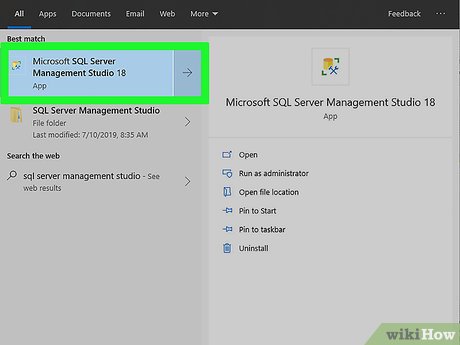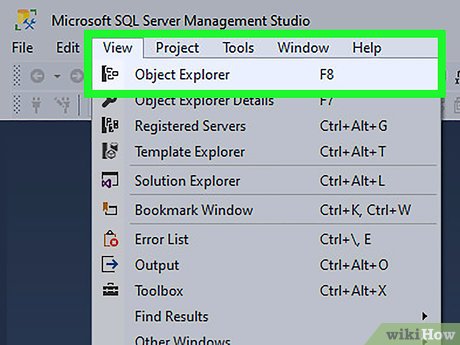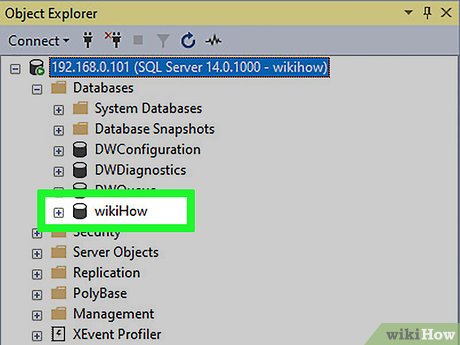How to Check the Query Performance in an SQL Server
Part 1 of 3:
Enabling the Query Store
-
 Open the SQL Server Management Studio. You can use the Query Store feature of SQL Server to monitor your database for performance issues. This feature is included with SQL Server 2016 and later, but you'll need to enable it manually.[1]
Open the SQL Server Management Studio. You can use the Query Store feature of SQL Server to monitor your database for performance issues. This feature is included with SQL Server 2016 and later, but you'll need to enable it manually.[1] -
 Open Object Explorer. If you don't see Object Explorer already, click the View menu at the top of the screen, then click Object Explorer.[2]
Open Object Explorer. If you don't see Object Explorer already, click the View menu at the top of the screen, then click Object Explorer.[2] -
 Right-click the database you want to check. A menu will appear.[3]
Right-click the database you want to check. A menu will appear.[3]- The Query Store can't be used to monitor the master or tempdb databases.
-
 Click Properties.
Click Properties. -
 Click Query Store. It's on the Properties dialog box.
Click Query Store. It's on the Properties dialog box. -
 Select On under ″Operation Mode (Requested).″ The Query Store will begin tracking all queries.
Select On under ″Operation Mode (Requested).″ The Query Store will begin tracking all queries. -
 Refresh the database in the Object Explorer panel. This adds the Query Store folder to the panel.
Refresh the database in the Object Explorer panel. This adds the Query Store folder to the panel. -
 Customize when the Query Store aggregates new data. The Query Store will aggregate new stats every 60 minutes by default. Here's how to change the interval (using 15 minutes as an example):[4]
Customize when the Query Store aggregates new data. The Query Store will aggregate new stats every 60 minutes by default. Here's how to change the interval (using 15 minutes as an example):[4]- ALTER DATABASE
- SET QUERY_STORE (INTERVAL_LENGTH_MINUTES = 15);.
Part 2 of 3:
Finding the Top Resource-consuming Queries
-
 Click the - next to ″Query Store″ in the Object Explorer. This displays all Query Store options.
Click the - next to ″Query Store″ in the Object Explorer. This displays all Query Store options.- Use this method to find out which specific queries are using the most server resources.[5]
-
 Click Top Resource Consuming Queries. This opens a graph that displays the 25 most resource-consuming queries in the database. These results are pretty broad, but you can further customize the graph to get more helpful information.[6]
Click Top Resource Consuming Queries. This opens a graph that displays the 25 most resource-consuming queries in the database. These results are pretty broad, but you can further customize the graph to get more helpful information.[6] -
 Click Configure. It's at the top-right corner of the report. A dialog window will appear.
Click Configure. It's at the top-right corner of the report. A dialog window will appear. -
 Select your resource consumption criteria. In the top section (″Resource Consumption Criteria″), choose which resource you want to check (e.g., CPU Time, Memory Consumption), and the desired statistic (e.g., Avg, Total).
Select your resource consumption criteria. In the top section (″Resource Consumption Criteria″), choose which resource you want to check (e.g., CPU Time, Memory Consumption), and the desired statistic (e.g., Avg, Total). -
 Select a time period. Under the ″Time Interval″ section, choose the time period for which you want to view results. You can select an option from the drop-down menu or insert specific dates into the provided boxes.
Select a time period. Under the ″Time Interval″ section, choose the time period for which you want to view results. You can select an option from the drop-down menu or insert specific dates into the provided boxes. -
 Choose how many results to see. To see all queries for the selected time period, click All under the ″Return″ header. To display a specific number of queries, select Top and enter a number (e.g. 10, 100).
Choose how many results to see. To see all queries for the selected time period, click All under the ″Return″ header. To display a specific number of queries, select Top and enter a number (e.g. 10, 100).- If you want to stick to the top 25 worst offenders, there's no need to make any changes under the ″Return″ header.
-
 Click OK. The stats will now refresh to display what you want to see.
Click OK. The stats will now refresh to display what you want to see. -
 Adjust the view (optional). Use the small graph icons (the grid, chart, and bar graph) to view the results in various formats. These buttons are at the top-right corner of the results.
Adjust the view (optional). Use the small graph icons (the grid, chart, and bar graph) to view the results in various formats. These buttons are at the top-right corner of the results.
Part 3 of 3:
Checking for Regressed Queries
-
 Click the - next to ″Query Store″ in the Object Explorer. This displays all Query Store options.
Click the - next to ″Query Store″ in the Object Explorer. This displays all Query Store options.- Use this method to find specific queries that are performing more slowly than they used to.[7]
-
 Click Regressed Queries. This opens the Regressed Queries panel, where you'll find the queries and plans in the Query Store.[8]
Click Regressed Queries. This opens the Regressed Queries panel, where you'll find the queries and plans in the Query Store.[8] -
 Select a plan from the first drop-down menu. It's the menu labeled ″Check for regression in″ above the top-left corner of the panel. Each of the plans will display a different graphical performance report for your queries.
Select a plan from the first drop-down menu. It's the menu labeled ″Check for regression in″ above the top-left corner of the panel. Each of the plans will display a different graphical performance report for your queries.- For example, if you want to check for issues with in the amount of time it takes for queries to run, select Duration.
- To see issues relating to RAM usage, select Memory Consumption.
-
 Select a statistic from the second drop-down menu. This is the menu labeled ″Based on″ (to the right of the previous menu. This re-displays the results.
Select a statistic from the second drop-down menu. This is the menu labeled ″Based on″ (to the right of the previous menu. This re-displays the results.
5 ★ | 1 Vote
You should read it
- MS Access 2003 - Lesson 23: Own query design
- The multiple-choice question set has an answer to Query P1
- MS Access 2003 - Lesson 22: Using Query Wizards
- Create data queries in Access 2016 from simple to complex
- Adjust performance in SQL Server: find slow queries
- How to use container queries in CSS
- Options to create data queries in Access 2016
- Alternate Criteria in Access 2016
May be interested
- Qappsrv (query termserver) command in Windows
 (applies to windows server (semi-annual channel), windows server 2016, windows server 2012 r2, windows server 2012)
(applies to windows server (semi-annual channel), windows server 2016, windows server 2012 r2, windows server 2012) - Good habits when writing T-SQL statements (Part 1)
 application performance depends on a lot of factors, including a very important factor that is the time for sql server to process t-sql statements. sometimes database design and complex query requirements impede the execution speed of t-sql statements. writing code for each t-sql statement can also make the sql server have to work harder to process the query.
application performance depends on a lot of factors, including a very important factor that is the time for sql server to process t-sql statements. sometimes database design and complex query requirements impede the execution speed of t-sql statements. writing code for each t-sql statement can also make the sql server have to work harder to process the query. - Qwinsta (query session) command in Windows
 (applies to windows server (semi-annual channel), windows server 2016, windows server 2012 r2, windows server 2012)
(applies to windows server (semi-annual channel), windows server 2016, windows server 2012 r2, windows server 2012) - Test SQL Server with Windows PowerShell - Part 5
 in this part 5, we will check whether we can connect to sql server and see if we can query some properties related to sql server.
in this part 5, we will check whether we can connect to sql server and see if we can query some properties related to sql server. - Test SQL Server with Windows PowerShell - Part 6
 part 6 will show you how to check all existing databases in the sql server instance and query the database properties.
part 6 will show you how to check all existing databases in the sql server instance and query the database properties. - 5 best SQL query optimization software to speed up MySQL
 the sql query optimizer analyzes many options for a given query, estimates the cost of each of these options, and finally, selects the lowest cost option.
the sql query optimizer analyzes many options for a given query, estimates the cost of each of these options, and finally, selects the lowest cost option. - 6 Ways to Check Which DNS Server is Being Used in Windows 11
 sometimes you'll want to see which dns server your pc is connecting to, either because the server you're using is down or because you want to switch to a faster or more secure alternative server.
sometimes you'll want to see which dns server your pc is connecting to, either because the server you're using is down or because you want to switch to a faster or more secure alternative server. - Check version information in SQL Server
 this article will show you in detail how to use the @@ version query to check the information that sql server version is using.
this article will show you in detail how to use the @@ version query to check the information that sql server version is using. - Action Query in Action 2016
 action queries are queries that perform actions on data, can add, change or delete records.
action queries are queries that perform actions on data, can add, change or delete records. - Check constraints in SQL Server
 what is the check constraint in sql server, what is it used for and what is it used for? this article will give you the answer.
what is the check constraint in sql server, what is it used for and what is it used for? this article will give you the answer.






















 How to Check Database Size in MySQL
How to Check Database Size in MySQL How to Delete Duplicate Records in Oracle
How to Delete Duplicate Records in Oracle How to Reset SA Password in Sql Server
How to Reset SA Password in Sql Server How to Learn Data Entry
How to Learn Data Entry How to Create a Database from an Excel Spreadsheet
How to Create a Database from an Excel Spreadsheet How to Keep and Control Records Using Microsoft Access
How to Keep and Control Records Using Microsoft Access